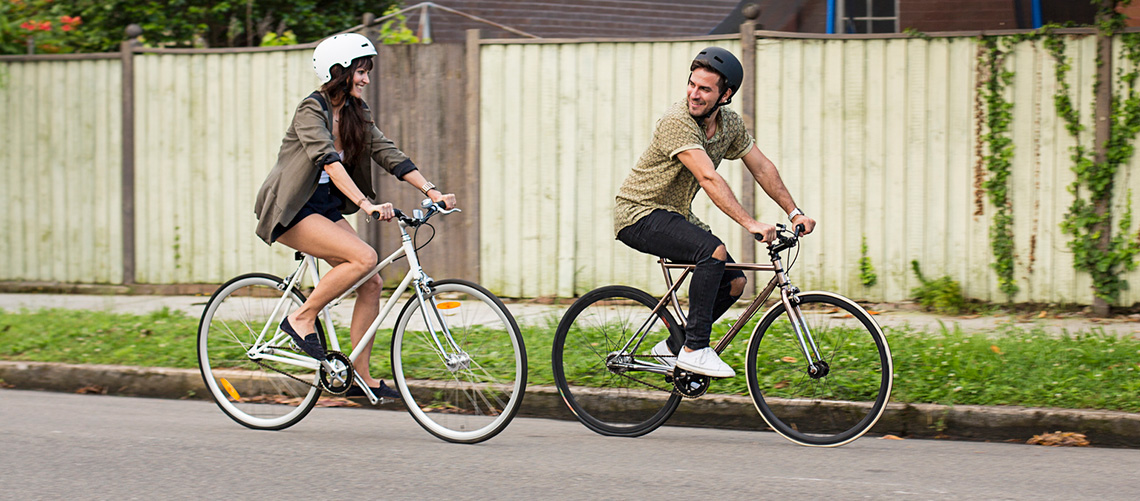Two, four or six wheels, powered by legs or engines, our roads are used by a variety of different vehicles and all need to work together to ensure traffic flows smoothly and safely.
Whether you opt for a pushbike, motorcycle, car or truck, the roads are there to share. An educated, courteous and respectful attitude improves the journey for everyone.
Read on to see the NRMA’s tips for how to share the road with cyclists and ensure all road users arrives at their destination safely.
How drivers can share the road with cyclists
Drivers need to be patient
Extra vigilance should be exercised when driving near cyclists, as they are harder to see (especially at night) and may have to react to additional hazards such as large road imperfections.
Pushbikes tend to travel slower than posted speed limits, however may move faster than the flow of slow-moving traffic. Don’t assume a cyclist is travelling at the same speed as other vehicles around them and always drive to the conditions.
While all motorists should be checking their mirrors and blind spots regularly anyway, extra care should be taken when a cyclist is nearby. Pushbikes have longer stopping distances than cars, so be careful when turning left across a cycle lane to avoid unintentionally cutting off a cyclist.
Always check your surroundings and don’t open a car door into the path of a cyclist; you are legally at fault if an accident ensues as cyclists are not required to keep space between themselves and parked cars.
Remember, even a minor collision between a cyclist and car is much more likely to result in serious injury compared to a minor collision between two cars.

Take care and leave space when overtaking
Cyclists have legal entitlements to ride in the centre of a lane and two abreast (side by side). This is not cause for frustration or tailgating.
After being trialled for two years, the NSW Government passed the Minimum Passing Distance Rule in 2018, which affects when and how drivers of motored vehicles may pass cyclists.
The Minimum Passing Distance Rule states drivers overtaking a cyclist must leave at least:
- one metre of space when the speed limit is 60km/h or less, or;
- 1.5 metres of space when the speed limit is more than 60km/h.
Drivers who do not leave these minimum distances when overtaking cyclists can be subject to a $349 fine and two demerit points.
To ensure the rule is adhered to, drivers are exempt from the following laws while overtaking a cyclist as long as they have a clear view of approaching traffic and leave a one-metre gap:
- Keep to the left of the centre of the road (two-way road with no dividing line);
- Keep to the left of the centre of a dividing line - broken and unbroken lines;
- Keep off a flat dividing strip;
- Keep off a flat painted island;
- Driving within a single marked lane or line of traffic, and;
- Moving from one marked lane to another across a continuous line separating the lanes.
How cyclists can share the road with cars
The onus for keeping our roads safe doesn’t just fall onto drivers of motored vehicles; cyclists also have a responsibility to follow road rules in place for their and other’s safety.Use dedicated bike lanes and stop where appropriate
Riders must use bicycle lanes wherever one is available. On roads without a dedicated bike lane, cyclists are encouraged to ride to the left of a lane, however this is not legally enforced.

A bicycle lane sign, taken from RMS NSW.
Cyclists have a legal entitlement to ride two abreast (side by side), however must not ride more than 1.5 metres apart.
Like motored vehicles, cyclists must also observe and come to a stop at:
-
children/pedestrian crossings;
-
red lights;
-
stop signs;
-
give way signs if there
is traffic travelling on the crossroad; - the entrance of a roadway, especially from driveways (not a legal requirement but advised), and;
- railway crossings when there is a stop sign, the crossing lights are flashing or the boom gate is down, a railway employee signals traffic to stop, or a train is coming.
Signal your intent and be courteous towards drivers
NSW law requires cyclists to indicate intent to turn across the flow of traffic or merge to the right lane with a hand signal. This signal must be made ‘about’ 30 metres prior to the maneuver. The law does not require cyclists to signal when turning left at an intersection.
Right turns can be made from the left lane of a multi-lane roundabout when on a bike, however riders must give way to any vehicle leaving the roundabout.
If riding at night, cyclists must display a flashing or steady white light from the front of their bike and a flashing or steady red light from the rear. Law also requires a red reflector be fitted and visible at the rear of the bike.
Stay calm just as motorists should
Under NSW law, a bicycle is considered a vehicle and are subject to many of the same expectations.
Cyclists can be charged for riding ‘furiously, recklessly or negligently’ just like motorists can. The road is made safer for everyone when a courteous and calm approach is taken.












